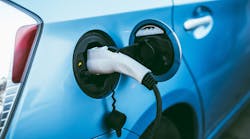According to onsemi, it has signed a “strategic agreement” with Volkswagen to supply high-voltage silicon-carbide (SiC) chips and modules that will power the traction inverters in VW’s modular platform for electric vehicles (EVs).
As a first step in the agreement, onsemi will supply its EliteSiC 1200-V 3x Half-Bridge power modules to be used in the automaker’s traction inverters. A traction inverter converts direct-current (dc) output by the battery pack in the EV into alternating current (ac) that powers the motor and subsequently turns the wheels. The chips will be used in inverters that will drive both the front and rear axles, covering a wide range of power levels.
Collaboration with Volkswagen has been ongoing for more than a year in efforts to optimize the power modules for VW’s EV platform. Pre-production samples are now in development and the evaluation stage.
The agreement also is apparently forward-looking, as onsemi pointed out that its EliteSiC family of power modules are pin-to-pin compatible to scale the inverter to meet different power levels and types of motors.
Benefits of SiC
As a wide-bandgap semiconductor, SiC has unique properties that enable it to distribute power in a way that limits losses while dissipating less heat than silicon devices. That means EVs can travel farther on a single charge or use more compact batteries with the same range. Even though power electronics based on SiC are more expensive than standard MOSFETs and IGBTs, SiC promises to reduce overall system costs.
Fast-switching properties also give it the advantage in energy efficiency. Furthermore, the higher switching speed allows for the immediate power stage to be surrounded with smaller inductors and other passive components as well as magnetics and transformers, which are generally the largest and most expensive parts of a system. That keeps the weight and size of power electronics in check.
The durability of the material helps it safely handle higher voltages and tolerate higher temperatures under the hood. As a result, the electrical resistance—also called the RDS(on) or resistance between the drain and source regions of the device during on-state operation—of SiC devices is reduced. This curtails power losses when the device converts power from one level to another, making it more efficient relative to IGBTs.
With all of these advantages, major automakers are taking silicon carbide more seriously, striking long-term purchase agreements with the likes of onsemi, Infineon, and Wolfspeed to shore up supplies of the power-heavy chips.
Widespread chip shortages have hit major car manufacturers hard in recent years. And as these companies prepare to roll out more EVs, they’re taking steps to lock in supplies of their most critical semiconductors.
Last year, Wolfspeed worked out a deal to supply General Motors with a new class of easy-to-cool power electronics based on SiC, and Stellantis announced that it reserved a “multiyear” supply of high-voltage SiC MOSFETs from Infineon.
Said Simon Keeton, EVP and GM of onsemi’s Power Solutions business unit, “Our investments in ramping production globally, especially in silicon carbide, further allow us to support VW’s rapidly scaling production with EVs.”

